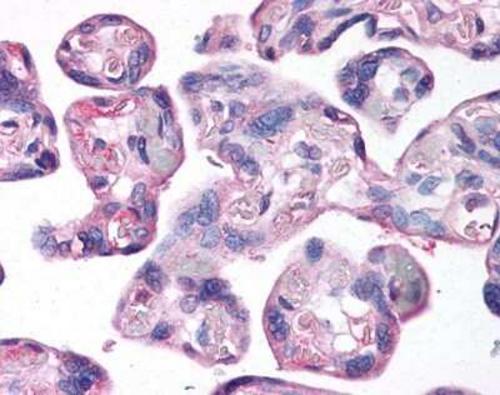LOX Rabbit Polyclonal Antibody
Frequently bought together (3)
Transient overexpression lysate of lysyl oxidase (LOX)
USD 396.00
Other products for "LOX"
Specifications
| Product Data | |
| Applications | IHC, WB |
| Recommended Dilution | Immunohistochemistry: 1:200, Simple Western: 1:100, Immunocytochemistry/ Immunofluorescence: 1:100, Western Blot: 1:500-1:1000, Immunohistochemistry-Paraffin: 1:200 |
| Reactivities | Human, Mouse, Rat, Porcine, Cow |
| Host | Rabbit |
| Isotype | IgG |
| Clonality | Polyclonal |
| Immunogen | A cocktail of two synthetic peptides; one made to a region of the human LOX protein within residues 300-400 and one within residues 200-300 |
| Formulation | Tris-glycine, 150mM NaCl and 0.02% sodium azide |
| Purification | Affinity purified |
| Conjugation | Unconjugated |
| Storage | Store at -20°C as received. |
| Stability | Stable for 12 months from date of receipt. |
| Gene Name | lysyl oxidase |
| Database Link | |
| Background | Lysyl oxidase (LOX), a copper-containing amine oxidase, belongs to a heterogeneous family of enzymes that oxidize primary amine substrates to reactive aldehydes. It plays a vital role in the formation and repair of the extracellular matrix. In addition, LOX is a multifunctional enzyme having diverse biological functions such as developmental regulation, tumor suppression, cell motility, and cellular senescence. The secreted form of LOX is responsible for the invasive properties of hypoxic human cancer cells. Thus, it is essential for hypoxia-induced metastasis and is a good therapeutic target for preventing and treating metastases. |
| Synonyms | MGC105112 |
| Reference Data | |
| Protein Families | Druggable Genome, Secreted Protein |
Documents
| Product Manuals |
| FAQs |
| SDS |
{0} Product Review(s)
0 Product Review(s)
Submit review
Be the first one to submit a review
Product Citations
*Delivery time may vary from web posted schedule. Occasional delays may occur due to unforeseen
complexities in the preparation of your product. International customers may expect an additional 1-2 weeks
in shipping.






























































































































































































































































 Germany
Germany
 Japan
Japan
 United Kingdom
United Kingdom
 China
China







